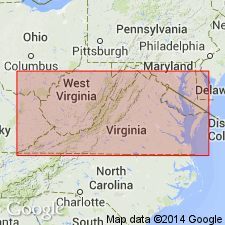
- Usage in publication:
-
- Grayson granite gneiss
- Modifications:
-
- Named
- Dominant lithology:
-
- Gneiss
- AAPG geologic province:
-
- Piedmont-Blue Ridge province
Jonas, A.I., 1928, Geological map of Virginia; preliminary edition: Virginia Geological Survey
Summary:
Grayson Gneiss named for Grayson Co., southwestern VA. Covers most of Grayson Co. Consists of porphyritic biotite granite gneiss containing pink to white feldspar phenocrysts with numerous dark schistose layers and cut by pegmatite. Probably equivalent to part of Cranberry granite. Age is Precambrian.
Source: GNU records (USGS DDS-6; Reston GNULEX).
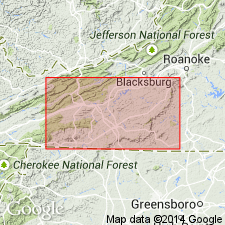
- Usage in publication:
-
- Grayson granite
- Modifications:
-
- Revised
- Age modified
Summary:
Grayson granite is represented by granodiorite from south of Roanoke to NC State line (about 100 mi). Described as green gneissic rock with abundant pink feldspars. In Grayson Co., injected by coarse- and fine-grained Air Point granite. Precambrian age is based on 3 lines of reasoning: 1) metabasalt flows, which form crest of Blue Ridge for long distances, cap Grayson. These flows are designated Precambrian in age because they are overlain unconformably by basal Cambrian Unicoi (Loudoun) quartzite. These flows should not be confused with thin basalt flows within Unicoi that occur from near Front Royal southwestward through VA). On the basis of helium content of flow in southwest VA, age of lower part of Unicoi is estimated at 450 Ma. In spite of nature of field relations of metabasalt to granodiorite and fact that intrusive relations of granodiorite to metabasalt have not been observed, some geologists have claimed that granodiorite is younger than metabasalt, perhaps Paleozoic in age. However, granodiorite is cut by metamorphosed diabase dikes of a composition related to metabasalt and dikes show metamorphism not characteristic of Paleozoic basic intrusives of the Valley, nor of Triassic diabase abundant eastward. If the dikes that cut granodiorite are related to metabasalt magma, their presence in granodiorite is further evidence that Grayson is older than overlying flows, which are themselves considered Precambrian; 2) in many places, overlying Unicoi quartzite is composed of material derived from the granodiorite. The fact that pebbles of hydrothermally altered Grayson occur in Cambrian rocks indicates both intrusion and alteration of granodiorite in Precambrian time; and 3) recent analyses of allanite from central part of granodiorite. Granodiorite of Nelson and Amherst Cos. contains allanite bearing pegmatite; one of these dikes is found in northwestern flank of the Friar, a granodiorite peak in northern Amherst Co. U/Th ratios of allanite indicate an age of 800 Ma, which corresponds to middle of Precambrian time. As the beginning of Cambrian time has been placed at 500 Ma, the granodiorite into which allanite-bearing pegmatite is intruded is several hundred million years older than Paleozoic, probably middle Precambrian in age.
Source: GNU records (USGS DDS-6; Reston GNULEX).
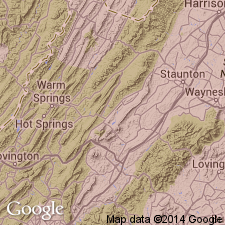
- Usage in publication:
-
- Grayson granodiorite gneiss*
- Modifications:
-
- Revised
- AAPG geologic province:
-
- Piedmont-Blue Ridge province
Summary:
Because of mineral composition, name is revised to Grayson granodiorite gneiss. Forms crest of Point Lookout Mountain, southeastern spurs of Brierpatch Mountain, and crest of Buck Mountain. Well exposed on VA Hwy 95 where road follows Knob Fork, and in gorge of Elk Creek from its mouth northwestward to Chestnut Flat. At Clito Mill, 0.5 mi north of the point where Elk Creek highway crosses Elk Creek, falls in creek are Grayson. Consists of coarse-grained porphyritic granodiorite gneiss with phenocrysts of pink and red microcline in a dark-colored matrix of dull-green feldspar, quartz, bronzy biotite, hornblende and epidote. Injected by aplite and diabase of Mt. [Mount] Rogers volcanic series.
Source: GNU records (USGS DDS-6; Reston GNULEX).
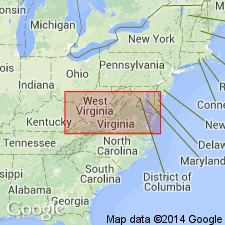
- Usage in publication:
-
- Grayson granodiorite gneiss
- Modifications:
-
- Revised
- AAPG geologic province:
-
- Piedmont-Blue Ridge province
Summary:
Grayson granodiorite gneiss included in Virginia Blue Ridge complex.
Source: GNU records (USGS DDS-6; Reston GNULEX).
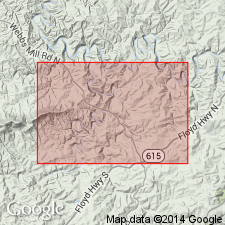
- Usage in publication:
-
- Grayson Gneiss, Grayson Augen Gneiss
- Modifications:
-
- Geochronologic dating
- Revised
- AAPG geologic province:
-
- Piedmont-Blue Ridge province
Summary:
Used as both Grayson Gneiss and Grayson Augen Gneiss. Report states K-Ar biotite age of 687+/-15 Ma and a Rb-Sr whole-rock isochron age of 1320+/-100 Ma for both Grayson Augen Gneiss and Little River Augen Gneiss.
Source: GNU records (USGS DDS-6; Reston GNULEX).
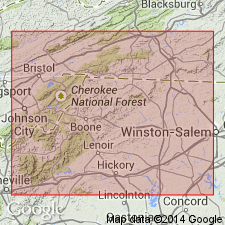
- Usage in publication:
-
- Grayson Gneiss
- Modifications:
-
- Age modified
- Geochronologic dating
- Not used
- AAPG geologic province:
-
- Piedmont-Blue Ridge province
Summary:
Authors report a revised Rb-Sr whole rock isochron age of 1174+/-14 Ma for Grayson Gneiss. Results of radiometric dating of both Grayson Gneiss and Little River Gneiss by Dietrich and others (1969) should not have been combined; authors did not have enough data to indicate that the two units have different 87Sr/86Sr ratios. Authors also state that Grayson rocks are included in Cranberry Gneiss of Elk Park plutonic suite by Rankin and others (1972).
Source: GNU records (USGS DDS-6; Reston GNULEX).
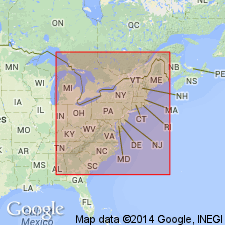
- Usage in publication:
-
- Grayson Granodiorite Gneiss*
- Modifications:
-
- Age modified
- Geochronologic dating
- AAPG geologic province:
-
- Piedmont-Blue Ridge province
Summary:
Six samples give Grayson Granodiorite Gneiss an age of 1149 Ma [Middle Proterozoic].
Source: GNU records (USGS DDS-6; Reston GNULEX).
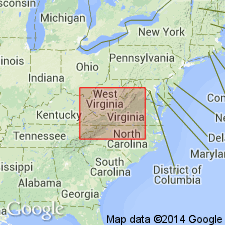
- Usage in publication:
-
- Grayson Gneiss
- Modifications:
-
- Revised
- AAPG geologic province:
-
- Piedmont-Blue Ridge province
Summary:
Grayson Gneiss removed from [Virginia] Blue Ridge Complex (herein abandoned) and reassigned to Forge Creek Suite.
Source: Modified from GNU records (USGS DDS-6; Reston GNULEX).
For more information, please contact Nancy Stamm, Geologic Names Committee Secretary.
Asterisk (*) indicates published by U.S. Geological Survey authors.
"No current usage" (†) implies that a name has been abandoned or has fallen into disuse. Former usage and, if known, replacement name given in parentheses ( ).
Slash (/) indicates name conflicts with nomenclatural guidelines (CSN, 1933; ACSN, 1961, 1970; NACSN, 1983, 2005, 2021). May be explained within brackets ([ ]).

